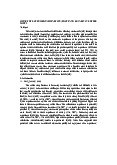

Preview text:
23:45 9/8/24 What is Cultural Integration
What is Cultural Integration?
Cultural Integration is when people from a culture adopt the essence of another culture while
maintaining their own culture. Rather than losing their own culture or keeping their own culture
and altogether rejecting the new culture, they fuse the two. They bring parts of their culture into
their communities through food, language, music, arts, attitudes, or traditions. They also adopt
elements of their new culture and adapt to local customs and ways of interacting. Examples of
this can be seen everywhere in American society.
The United States is often called a melting pot, meaning many cultures come together and
"melt" or fuse into one more diverse culture. One evidence of this that can be seen in society is
the variety of restaurants and food options in America that come from various cultures around
the world. Cultural integration can also occur through books, movies, and media exports.
Importance of Cultural Integration
Cultural Integration helps foster a sense of unity within a community. It also enhances a
community by allowing people to experience that they may not have access to otherwise. For
example, people can learn about the language, food, traditions, and arts of other cultures around
them without travelling to those countries of origin. This fosters respect for different cultures and
creates more informed and well-rounded citizens.
Integration is vital because, unlike assimilation, people maintain their culture and the parts of
their cultural identity that are important to them. They retain their culture by practising it at home
and in their community. They shun the new culture and allow themselves to be entirely absorbed.
Instead, they integrate into the larger culture without losing their own essence.
Cultural Integration Pros
Cultural Integration has several benefits: Increased diversity
Increases cultural awareness and promotes respect for other cultures
Enhances a person's life by enriching it with other cultures
Enhances the workplace environment and increases productivity, creativity, and knowledge
Increases multicultural competency
One of the most apparent benefits of cultural integration is diversity. It helps individuals learn
about, experience, and respect other cultures. This reduces fear of the unknown. It also creates an
environment more open to constructive dialogue and mutual respect. As a result, individuals can
experience the richness of other cultures and incorporate their best parts into their identity without losing their own.
Cultural integration creates a workplace environment where people can work and create with
unity, but not necessarily in unison. Each person can bring unique perspectives, experiences,
insight, and knowledge, resulting in better products and more efficient marketing. Diverse teams
where assimilation is optional can often be more productive and creative. In schools, students
learn to have respect and empathy for those that are different or have different cultures or ways about:blank 1/2 23:45 9/8/24 What is Cultural Integration
of doing things. Communities benefit from the infusion of culture, food, and the arts. Integration
can place the world at a person's doorstep, increasing their multicultural competency.
Cultural Integration Cons
Although there are many positive benefits to Cultural Integration, there are also some notable concerns:
Risk of assimilation rather than proper integration
Large shifts in ideology and altering existing cultural
Differences in values and opinions that lead to conflict
Some people worry that cultural integration means a dominant culture is imposing its ways on a
weaker or minority culture. They point to historical examples of forced assimilation, such as
Native American cultures in the 18th and 19th centuries. Others are concerned about the impact
on the existing culture when large groups immigrate and assimilate in a short amount of time.
They worry that cultural integration can have so much influence that it alters parts of the culture
until it only resembles its original makeup. In addition, specific patterns of cultural attitudes of
immigrant groups can significantly affect their community. One example is a political or
religious ideology. Where there are varying cultures, there will also be differences of opinion.
These may cause disagreements or conflict. about:blank 2/2




